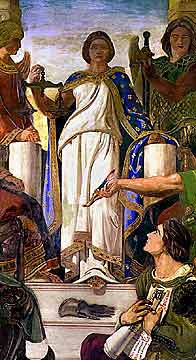The Spirit of Justice
© 2007
Armchair Travel Co. Ltd. - This page may be used for non-commercial purposes
ONLY!
![]()

[ Play
Narrated and Animated Movie ! ] The Spirit of Justice, conventionally female, stands, holding the balance which is her symbol. Her other symbol, the sword, is in the hands of the winged figure at her left shoulder. Before her, at the foot of the steps, figures stand and kneel, suppliants for her aid: figures representing many races, and people of all conditions and all ages.
The picture is a reminder that, in this home of legislation, the Spirit of Justice should always be present.
In comparison to those in the Robing Room or the Royal Gallery the mural paintings in the Lord's Chamber are, if anything, recessive rather than dominant. It has been hard for them to compete with the craftsmanship of Pugin's interior details, in particualr the maginificance of the throne.
At the time of the commission Victorian historians were looking back to the Middle Ages and their teaching proclaimed the virtues of the 'High Middle Ages'. The commissioning body chose subject matter which therefore extolled such virtues which the Victorian Age sought in its society: justice, religion and chivalry. Three frescoes directly represent these, whilst in the other three these virtues are expressed in historical narrative. In one, Prince Henry encounters the meaning of justice; in another, King Ethelbert is baptised into the Church in recognition of religion; and Edward III expresses the spirit of chivalry by founding the Order of the Garter, and making his son a knight.
[ Virtual
Tour ] [ Main Topics
Index ]


Additional Information on
The Spirit of Justice
Explore-Parliament.net: Advanced Category Search
Keyword Categories:
_Object_Painting
_Object_Artwork
_Event_Literary
_Artist_Maclise
_Spirit